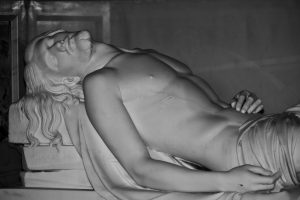ARCHIVAL MOMENT
March 9, 1855
Edward Morris a St. John’s businessman and politician in his diary dated March 9, 1855 wrote:
“went to the Cathedral (now the Basilica) to see Hogan’s sculptured ‘Dead Christ’ which was placed today under the Great Altar. A magnificent piece of art ordered by Dr. Fleming , (Bishop Michael Anthony Fleming) before his death. It cost 600 ponds sterling in Rome besides the expense of freight.”
“The Dead Christ” – was sculpted in Carrara marble by the Irish sculptor John Hogan in 1854. Bishop John Thomas Mullock, on one of his visits to Rome, purchased the statue and had it placed beneath the table of the High Altar on March 9, 1855.
Since it was installed in the Basilica it has twice been moved to new locations, first in 1903 when the Sanctuary was expanded and again in the early 1970’s when it was moved to its present position.
The statue is Hogan’s masterpiece. One observer of the statue wrote:
“It is an awesome and beautiful work of art, full of dignity, and conveying a sense of the serenity which follows the acceptance of God’s will and the peace which is a prelude to the glory of the Resurrection.”
Hogan created two other versions of the statue; the first version (1829) is located in St. Therese’s Church, Dublin, Ireland, the second (1833) in St. Finbarr’s (South) Church, Cork, Ireland. Other works by Hogan include the Sleeping Shepherd and The Drunken Faun. Hogan assured his international reputation in 1829 with The Dead Christ; thereafter, his creations were snapped up by Irish bishops visiting his Rome studio.
Hogan was recognized by by his fellow artist, he was pronounced by the Danish sculptor Bertel Thorwaldsen as “the best sculptor I leave after me in Rome.”
Hogan was a great supporter of the Irish movement for independence and went on to create a marble statue of Daniel O Connell, an important figure in the movement. The statue stands today at City Hall Dublin, the same spot where O’Connell gave his first speech against the Act of Union in 1800.
Hogan died at his home in Dublin, in 1858.
Recommended Archival Collection: Edward Morris Diaries, Archives of the Roman Catholic Archdiocese of St. John’s, NL.
Recommended Reading: A full account of Hogan’s life and works, with a catalogue raisonée and bibliography, is given by John Turpin in John Hogan: Irish Neoclassical Sculptor in Rome (Irish Academic Press, 1982).
Recommedned Tour: Visit the Basilica Cathedral in St. John’s and enjoy the large collection of art work that adorns the building. The Basilica Cathedral is home to art created by internationally celebrated artists like John Hogan, Edward Carew, Louis Koch, and Gerry Squires. If you were visting another city you would likely visit the Cathedrals and museums, why not do it in your own city!
